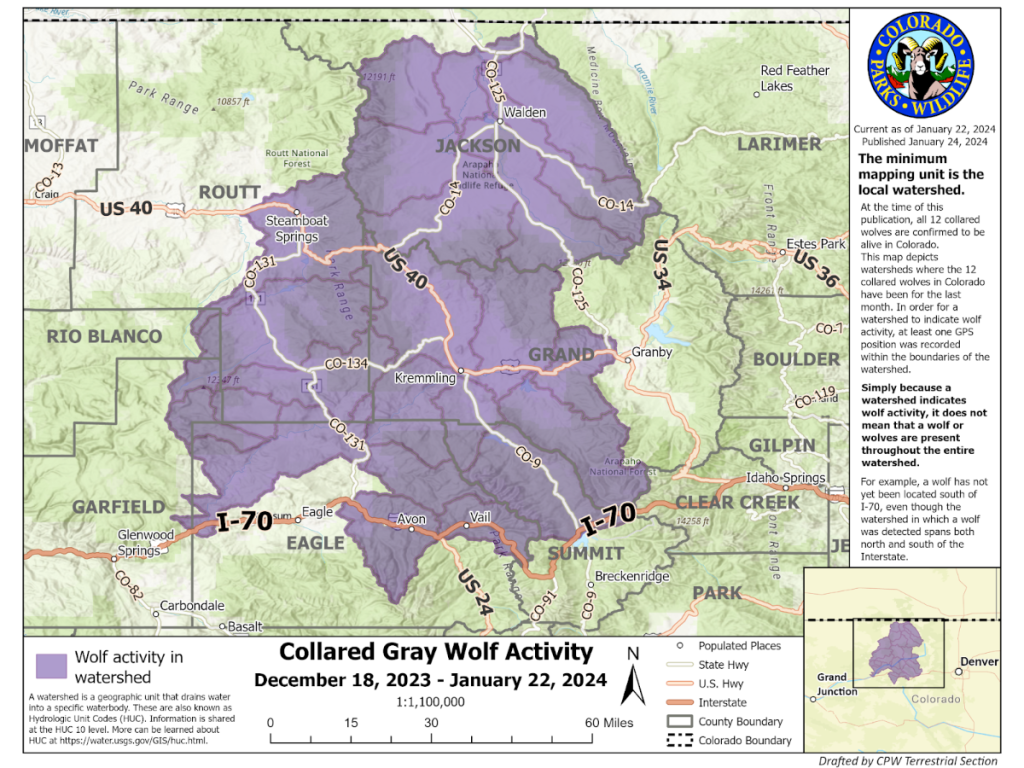
Collared gray wolf activity recorded by CPW from Dec. 18, 2023 to Jan. 22, 2024. Larger map is linked below and available at cpw.state.co.us.
DENVER - A map published today on Colorado Parks and Wildlife’s website will inform the public, recreationists and livestock producers on where wolves have been in the past month. This map will be updated with new information on a monthly basis, produced on the fourth Wednesday of every month, and will reflect data for the prior month, give or take several days.
These maps are created using GPS collar data collected from all 12 collared wolves in Colorado. This includes the 10 animals reintroduced from Oregon, as well as the two collared wolves in North Park.
About the GPS collar data
- Currently, the collars are programmed to record a position every four hours.
- Once four locations have been recorded, the packet of four locations is then transmitted via satellite to CPW biologists.
- The frequency of both position recording and transmission of the data can be delayed by a number of factors such as dense cloud cover, closed terrain, etc.
- By looking at the data, CPW staff can learn where wolves have been, but they cannot tell where wolves are at a current point in time, nor can they predict where the wolves will go.
- To protect the wolves, specific GPS data will not be shared.
Learn more about living and recreating in wolf country on
our website. CPW also created this
hands-on resource guide to help reduce wolf depredations on livestock.
CPW’s new Map Indicating Current Collared Wolf Activity in Colorado.
This map depicts watersheds where the 12 collared wolves in Colorado have been for the last month. A watershed is a geographic unit that drains water into a specific waterbody. These are also known as Hydrologic Unit Codes (HUC). Information is shared at the HUC 10 level. Watersheds are the appropriate mapping unit to display wolf activity information because wolves are far more likely to use geographic features to affect their distribution than they are political boundaries. The HUC 10 scale provides detailed information that can help agricultural producers be informed of the general areas where wolf activity is known to exist without being too general (i.e. as a county level map would be), and also is not so specific so as to risk the protection of individual wolves (as a finer scale HUC12 map would be). More can be learned about HUCs at
water.usgs.gov/GIS/huc.html.
In order for a watershed to indicate wolf activity, at least one GPS point from the wolf collars was recorded within the boundaries of the watershed.
Simply because a watershed indicates wolf activity, it does not mean that a wolf or wolves are present throughout the entire watershed nor that they are currently in the watershed. For example, a wolf has not yet been located south of I-70, even though the watershed in which a wolf was detected spans both north and south of the Interstate.
CPW reserves the right to buffer maps that will be shared with the public if doing so protects wolf welfare during sensitive times of the year (e.g., mating season).
At this point, all known wolves in Colorado have functional GPS collars. This allows for an accurate depiction of the watersheds where wolves are known to be active. It should be expected that through immigration from other states and natural reproduction of pups, the proportion of wolves that have collars will be reduced over time. Therefore, the accuracy of this map will be diminished over time as the activity of uncollared wolves may not be included in this map.
###

